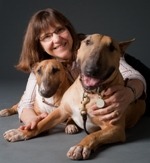-
Adopt
-
Veterinary Care
Services
Client Information
- What to Expect – Angell Boston
- Client Rights and Responsibilities
- Payments / Financial Assistance
- Pharmacy
- Client Policies
- Our Doctors
- Grief Support / Counseling
- Directions and Parking
- Helpful “How-to” Pet Care
Online Payments
Referrals
- Referral Forms/Contact
- Direct Connect
- Referring Veterinarian Portal
- Clinical Articles
- Partners in Care Newsletter
CE, Internships & Alumni Info
CE Seminar Schedule
Emergency: Boston
Emergency: Waltham
Poison Control Hotline
-
Programs & Resources
- Careers
-
Donate Now
 by Terri Bright, Ph.D., BCBA-D, CAAB
by Terri Bright, Ph.D., BCBA-D, CAAB
angell.org/behavior
behavior@angell.org
617-989-1520
Nothing makes everyone happier than having puppies in the veterinary office. Clients bring them soon after they purchase or adopt them, to make sure the pup is healthy, and to begin the process of vaccinations and a lifetime of health. Everyone oohs and ahs over them, but what are the most important things a vet and their staff can do to make sure the pup grows up to be happy and behaviorally healthy?
First, find out what the puppy’s history is. Was it imported from a kennel or rescue group in the southern part of the U.S.? Was it from a puppy mill (often located in the central U.S.)? In either of these cases, it is likely the pup was not socialized properly to other dogs or to people. Normal canine socialization starts at age 4 weeks and lasts a relatively short time, until 3 or 4 months of age. During these short weeks, the pup’s physiology allocates development towards the their learning the social language of dogs, as well as learning that people of all shapes and sizes can be tolerated without fear, as can novel sounds and sights. Along with being under-socialized, these puppies may have been traumatized while being transported to their new home. The third part of this possible puppy triumvirate is that the puppy may have been improperly bred, e.g., its relatives did not have confident, non-fearful/aggressive temperaments. A puppy bred by a reputable breeder may or may not escape under-socialization as the breeder attempts to keep the puppy from being exposed to disease, and a perfect topline, bite, or history of breed championships may trump breeding for temperament.
If under-socialization is the case with the puppy, it is imperative that the puppy is exposed, gently, to a multitude of other dogs and people before it is four months old. If the pup has to wait until it is sixteen weeks old and has had all its vaccinations, it is at risk of growing up to be fearful of novel sounds and people, and unable to communicate normally with other dogs. Sadly, this is a permanent condition. In much the same way that a human child will never be able to learn language if they are not spoken or signed to by the time they are about four years old, a puppy that has been under-socialized at this early age is always at risk of being fearful and may struggle with normal socialization with other dogs and people. The American Veterinary Society of Animal Behaviorists’ position statement advocates early socialization, saying that under-socialized dogs are at greater risk of death from euthanasia for behavioral reasons than they are from dying from disease caught by lack of vaccination. It is, therefore a valuable service you are providing to your clients to read the literature on puppy socialization and to help your clients make the best decision for socializing their puppy.
 How to best socialize the puppy? Ideally, socialization should not consist of simply exposing the pup to every person, place, dog, or thing. Instead, puppies should be exposed to novel stimuli at a distance at which the pup can cope with the newness, and an escape option should be in place should the puppy get frightened. Thus, if a neighbor is a tall and robust dog lover, and this huge person leans right over the puppy, causing it to back up, urinate a bit, even growl, make sure the pup can escape, and the owner should say, “Give the pup some space, he/she is scared, thanks.” The same is true with dog socialization: the pup should be exposed to puppies of a similar size and/or play style; for example, a 10-week-old Parson Russell terrier could be a good match for an adult border collie, and too much for a timid 10-week-old Goldendoodle. If the owner is going to take their pup to a socialization class, they should make sure that:
How to best socialize the puppy? Ideally, socialization should not consist of simply exposing the pup to every person, place, dog, or thing. Instead, puppies should be exposed to novel stimuli at a distance at which the pup can cope with the newness, and an escape option should be in place should the puppy get frightened. Thus, if a neighbor is a tall and robust dog lover, and this huge person leans right over the puppy, causing it to back up, urinate a bit, even growl, make sure the pup can escape, and the owner should say, “Give the pup some space, he/she is scared, thanks.” The same is true with dog socialization: the pup should be exposed to puppies of a similar size and/or play style; for example, a 10-week-old Parson Russell terrier could be a good match for an adult border collie, and too much for a timid 10-week-old Goldendoodle. If the owner is going to take their pup to a socialization class, they should make sure that:
- There is at least one staff person to every three dogs, and rewards-based training only is used;
- There are adult dogs in the class who can gently teach dog socialization skills to the puppies;
- The puppies will be matched for the best play outcome, as per above ‑ size and style of play, rather than breed alone, and reciprocal play is shaped during the class. This means pups take turns chasing each other and being on top (or bottom) during a wrestling match, and no puppies are allowed to bully other puppies;
- Puppies are allowed to escape to a “safe place” during class should they feel the need.
If the puppy owner is going to socialize a puppy at a dog park, the above items 2-4 should be adapted: make sure owners are attending to their dogs; that adult dogs are tolerating the puppy; that turn-taking is evident during play; and that puppies can get away from other dogs easily. For most puppies, a pre-arranged meet-up with known dogs at a dog park will be much safer and productive than tossing the puppy into a typical dog-park free-for-all.
In the home, the puppy should have a variety of toys, and the owner should rotate them so they retain their interest. Crate-training is recommended, and can be accomplished by feeding the pup in its crate, leaving treats and toys in there for the puppy to find, and leaving the puppy in there a few minutes at a time, gradually building up to longer stays. The crate will also help to housetrain the puppy, as the owner can take the pup outside as soon as it comes out of the crate, and reward it for going in a designated spot outside. The puppy can be taught to ring a bell that hangs at its nose level on the door it goes out, so it can tell the owner when it needs to go out. Until the puppy can 1) recognize it’s better to eliminate outdoors and 2) let the owner know they need to go out, it should be crated or under the owner’s direct supervision at all times. When the puppy goes from playing or being calm to putting its nose on the floor, it should be hustled outdoors to go to the bathroom. If the puppy has an accident, the puppy should not be punished or scolded, or it could start to hide where it goes indoors.
Lastly, the puppy’s first veterinary visits will leave a lasting impression, so go slowly with the puppy, pairing fear-provoking stimuli such as stethoscopes and syringes with tasty treats. Sit on the floor with the pup, rather than leaning over him. Have a few squeaky toys on hand to interest the puppy. If the pup moves away or growls, give him or her a break. Do not scold or punish them, as they are just telling you they are frightened. Sophia Yin’s books and videos give lots of helpful how-to’s in this regard.
By following these guidelines, a puppy’s community can help them grow into a well-adjusted dog that plays well with others and is a behaviorally healthy family member.
For more information, please contact Angell’s Behavior service at 617-989-1520 or behavior@angell.org.